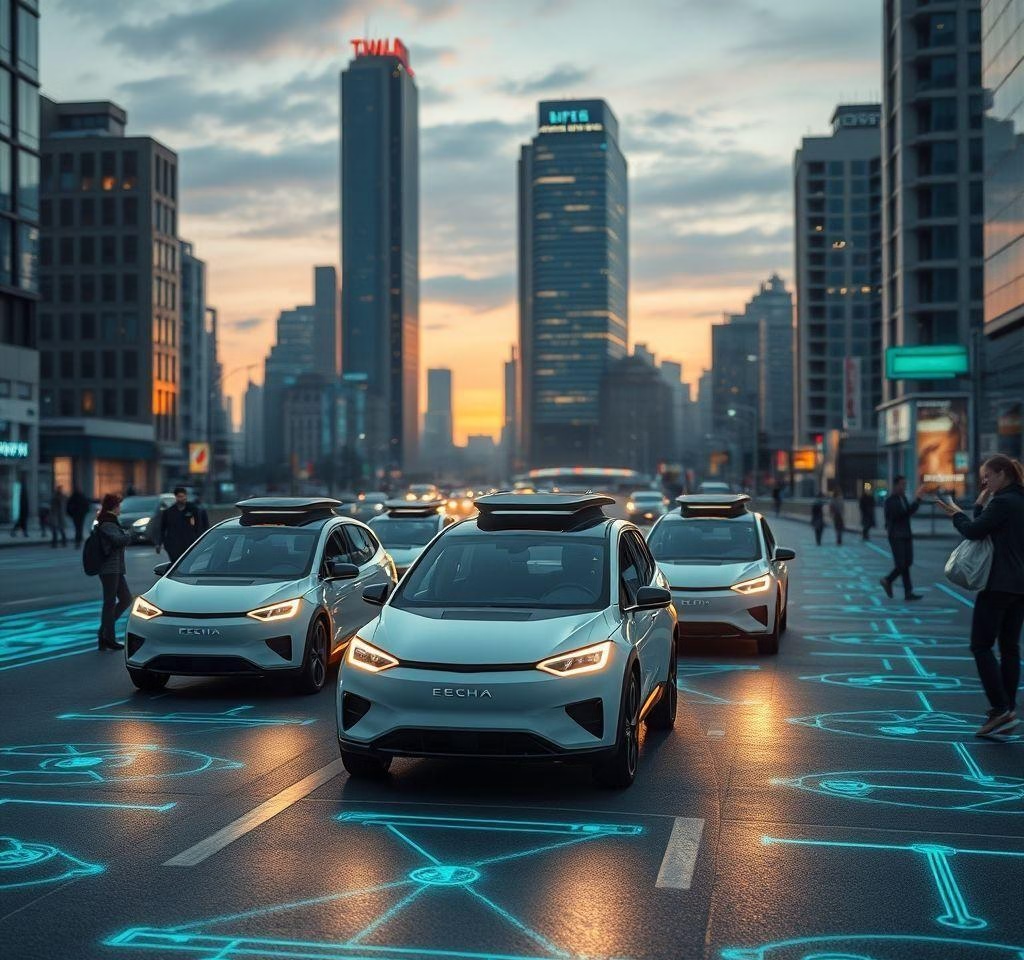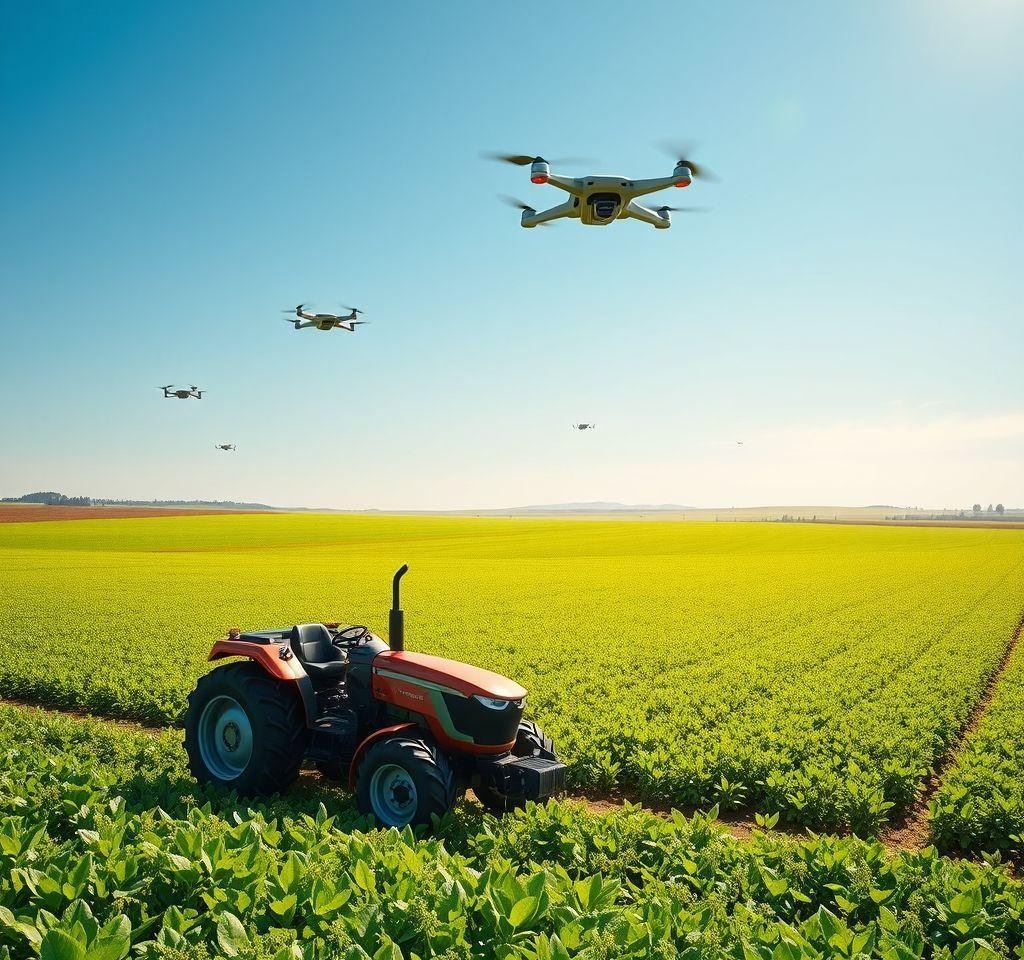The Future of Mobility: Self-Driving Cars with AI
Self-Driving Cars with AI represent a transformative leap in transportation. This article examines their technological underpinnings, societal implications, and the path to widespread adoption. By dissecting current breakthroughs and challenges, readers gain a holistic view of this mobility revolution.
The Foundation of Autonomous Vehicles
The Foundation of Autonomous Vehicles
Autonomous vehicles rely on a complex interplay of technologies. AI algorithms are central, using neural networks to process sensor data and make driving decisions. These networks learn from vast datasets, enabling the vehicle to recognize objects, predict their movements, and navigate safely.
LiDAR, a remote sensing method, creates a 3D map of the vehicle’s surroundings. This detailed point cloud is crucial for precise object detection and localization. Camera systems provide visual information, enhancing the vehicle’s perception. They supplement LiDAR’s data, helping identify objects and road markings.
Real-time processing is paramount. The vehicle must instantly interpret sensory data to respond safely and effectively. This requires high-performance computing and optimized algorithms. Sensor fusion combines data from various sources, increasing accuracy and robustness. By integrating information from LiDAR, cameras, and other sensors, the vehicle gains a more comprehensive understanding of its environment, resulting in safer and more reliable navigation.
Current Breakthroughs in AI-Driven Mobility
The Foundation of Autonomous Vehicles
Autonomous vehicles rely on a complex interplay of technologies. AI algorithms are central, using neural networks to process sensor data and make driving decisions. These networks learn from vast datasets, enabling the vehicle to recognize objects, predict their movements, and navigate safely.
LiDAR, a remote sensing method, creates a 3D map of the vehicle’s surroundings. This detailed point cloud is crucial for precise object detection and localization. Camera systems provide visual information, enhancing the vehicle’s perception. They supplement LiDAR’s data, helping identify objects and road markings.
Real-time processing is paramount. The vehicle must instantly interpret sensory data to respond safely and effectively. This requires high-performance computing and optimized algorithms. Sensor fusion combines data from various sources, increasing accuracy and robustness. By integrating information from LiDAR, cameras, and other sensors, the vehicle gains a more comprehensive understanding of its environment, resulting in safer and more reliable navigation.
Navigating the Regulatory and Safety Landscape
The Foundation of Autonomous Vehicles
Autonomous vehicles rely on a complex interplay of technologies. AI algorithms are central, using neural networks to process sensor data and make driving decisions. These networks learn from vast datasets, enabling the vehicle to recognize objects, predict their movements, and navigate safely.
LiDAR, a remote sensing method, creates a 3D map of the vehicle’s surroundings. This detailed point cloud is crucial for precise object detection and localization. Camera systems provide visual information, enhancing the vehicle’s perception. They supplement LiDAR’s data, helping identify objects and road markings.
Real-time processing is paramount. The vehicle must instantly interpret sensory data to respond safely and effectively. This requires high-performance computing and optimized algorithms. Sensor fusion combines data from various sources, increasing accuracy and robustness. By integrating information from LiDAR, cameras, and other sensors, the vehicle gains a more comprehensive understanding of its environment, resulting in safer and more reliable navigation.
Benefits for Society and Transportation Systems
The Foundation of Autonomous Vehicles
Autonomous vehicles rely on a complex interplay of technologies. AI algorithms are central, using neural networks to process sensor data and make driving decisions. These networks learn from vast datasets, enabling the vehicle to recognize objects, predict their movements, and navigate safely.
LiDAR, a remote sensing method, creates a 3D map of the vehicle’s surroundings. This detailed point cloud is crucial for precise object detection and localization. Camera systems provide visual information, enhancing the vehicle’s perception. They supplement LiDAR’s data, helping identify objects and road markings.
Real-time processing is paramount. The vehicle must instantly interpret sensory data to respond safely and effectively. This requires high-performance computing and optimized algorithms. Sensor fusion combines data from various sources, increasing accuracy and robustness. By integrating information from LiDAR, cameras, and other sensors, the vehicle gains a more comprehensive understanding of its environment, resulting in safer and more reliable navigation.
Ethical Considerations and the Road Ahead
The Foundation of Autonomous Vehicles
Autonomous vehicles rely on a complex interplay of technologies. AI algorithms are central, using neural networks to process sensor data and make driving decisions. These networks learn from vast datasets, enabling the vehicle to recognize objects, predict their movements, and navigate safely.
LiDAR, a remote sensing method, creates a 3D map of the vehicle’s surroundings. This detailed point cloud is crucial for precise object detection and localization. Camera systems provide visual information, enhancing the vehicle’s perception. They supplement LiDAR’s data, helping identify objects and road markings.
Real-time processing is paramount. The vehicle must instantly interpret sensory data to respond safely and effectively. This requires high-performance computing and optimized algorithms. Sensor fusion combines data from various sources, increasing accuracy and robustness. By integrating information from LiDAR, cameras, and other sensors, the vehicle gains a more comprehensive understanding of its environment, resulting in safer and more reliable navigation.
The Foundation of Autonomous Vehicles
Current Breakthroughs in AI-Driven Mobility
AI is rapidly advancing autonomous vehicle capabilities. Significant progress has been made in navigation, using more sophisticated algorithms to optimize routes and handle complex traffic scenarios. Object detection has improved with enhanced sensor technology and more robust AI models, enabling better recognition of pedestrians, cyclists, and other vehicles. Predictive modeling allows vehicles to anticipate the actions of other road users, improving safety and efficiency.
Recent advancements in sensor technology have also improved data quality. This allows for more accurate AI model training and more robust performance in challenging conditions. However, real-world deployment presents challenges. Edge cases, such as unexpected events, require careful consideration. Weather adaptation is also critical for reliable operation in diverse climates. Ongoing research focuses on improving these areas to ensure safe and effective deployment of self-driving cars.
Current Breakthroughs in AI-Driven Mobility
Current Breakthroughs in AI-Driven Mobility
AI is rapidly advancing autonomous vehicle capabilities. Significant progress has been made in navigation, using more sophisticated algorithms to optimize routes and handle complex traffic scenarios. Object detection has improved with enhanced sensor technology and more robust AI models, enabling better recognition of pedestrians, cyclists, and other vehicles. Predictive modeling allows vehicles to anticipate the actions of other road users, improving safety and efficiency.
Recent advancements in sensor technology have also improved data quality. This allows for more accurate AI model training and more robust performance in challenging conditions. However, real-world deployment presents challenges. Edge cases, such as unexpected events, require careful consideration. Weather adaptation is also critical for reliable operation in diverse climates. Ongoing research focuses on improving these areas to ensure safe and effective deployment of self-driving cars.
Navigating the Regulatory and Safety Landscape
Current Breakthroughs in AI-Driven Mobility
AI is rapidly advancing autonomous vehicle capabilities. Significant progress has been made in navigation, using more sophisticated algorithms to optimize routes and handle complex traffic scenarios. Object detection has improved with enhanced sensor technology and more robust AI models, enabling better recognition of pedestrians, cyclists, and other vehicles. Predictive modeling allows vehicles to anticipate the actions of other road users, improving safety and efficiency.
Recent advancements in sensor technology have also improved data quality. This allows for more accurate AI model training and more robust performance in challenging conditions. However, real-world deployment presents challenges. Edge cases, such as unexpected events, require careful consideration. Weather adaptation is also critical for reliable operation in diverse climates. Ongoing research focuses on improving these areas to ensure safe and effective deployment of self-driving cars.
Benefits for Society and Transportation Systems
Current Breakthroughs in AI-Driven Mobility
AI is rapidly advancing autonomous vehicle capabilities. Significant progress has been made in navigation, using more sophisticated algorithms to optimize routes and handle complex traffic scenarios. Object detection has improved with enhanced sensor technology and more robust AI models, enabling better recognition of pedestrians, cyclists, and other vehicles. Predictive modeling allows vehicles to anticipate the actions of other road users, improving safety and efficiency.
Recent advancements in sensor technology have also improved data quality. This allows for more accurate AI model training and more robust performance in challenging conditions. However, real-world deployment presents challenges. Edge cases, such as unexpected events, require careful consideration. Weather adaptation is also critical for reliable operation in diverse climates. Ongoing research focuses on improving these areas to ensure safe and effective deployment of self-driving cars.
Ethical Considerations and the Road Ahead
Current Breakthroughs in AI-Driven Mobility
AI is rapidly advancing autonomous vehicle capabilities. Significant progress has been made in navigation, using more sophisticated algorithms to optimize routes and handle complex traffic scenarios. Object detection has improved with enhanced sensor technology and more robust AI models, enabling better recognition of pedestrians, cyclists, and other vehicles. Predictive modeling allows vehicles to anticipate the actions of other road users, improving safety and efficiency.
Recent advancements in sensor technology have also improved data quality. This allows for more accurate AI model training and more robust performance in challenging conditions. However, real-world deployment presents challenges. Edge cases, such as unexpected events, require careful consideration. Weather adaptation is also critical for reliable operation in diverse climates. Ongoing research focuses on improving these areas to ensure safe and effective deployment of self-driving cars.
The Foundation of Autonomous Vehicles
Navigating the Regulatory and Safety Landscape
Autonomous vehicles face a complex regulatory landscape. Global frameworks vary significantly, impacting development and deployment. Harmonizing regulations is crucial for widespread adoption. Ethical dilemmas arise in accident scenarios. Determining liability in unavoidable accidents requires careful legal consideration. Robust safety protocols are essential, including comprehensive testing and fail-safe mechanisms. These protocols are designed to mitigate risks and ensure public safety.
Public perception is a key factor. Addressing safety concerns and building public trust are vital. Transparency about the technology’s capabilities and limitations is crucial. Insurance implications are substantial. New insurance models are needed to address liability in autonomous driving accidents. The future requires a collaborative approach to establish clear regulations and safety standards.
Current Breakthroughs in AI-Driven Mobility
Navigating the Regulatory and Safety Landscape
Autonomous vehicles face a complex regulatory landscape. Global frameworks vary significantly, impacting development and deployment. Harmonizing regulations is crucial for widespread adoption. Ethical dilemmas arise in accident scenarios. Determining liability in unavoidable accidents requires careful legal consideration. Robust safety protocols are essential, including comprehensive testing and fail-safe mechanisms. These protocols are designed to mitigate risks and ensure public safety.
Public perception is a key factor. Addressing safety concerns and building public trust are vital. Transparency about the technology’s capabilities and limitations is crucial. Insurance implications are substantial. New insurance models are needed to address liability in autonomous driving accidents. The future requires a collaborative approach to establish clear regulations and safety standards.
Navigating the Regulatory and Safety Landscape
Navigating the Regulatory and Safety Landscape
Autonomous vehicles face a complex regulatory landscape. Global frameworks vary significantly, impacting development and deployment. Harmonizing regulations is crucial for widespread adoption. Ethical dilemmas arise in accident scenarios. Determining liability in unavoidable accidents requires careful legal consideration. Robust safety protocols are essential, including comprehensive testing and fail-safe mechanisms. These protocols are designed to mitigate risks and ensure public safety.
Public perception is a key factor. Addressing safety concerns and building public trust are vital. Transparency about the technology’s capabilities and limitations is crucial. Insurance implications are substantial. New insurance models are needed to address liability in autonomous driving accidents. The future requires a collaborative approach to establish clear regulations and safety standards.
Benefits for Society and Transportation Systems
Navigating the Regulatory and Safety Landscape
Autonomous vehicles face a complex regulatory landscape. Global frameworks vary significantly, impacting development and deployment. Harmonizing regulations is crucial for widespread adoption. Ethical dilemmas arise in accident scenarios. Determining liability in unavoidable accidents requires careful legal consideration. Robust safety protocols are essential, including comprehensive testing and fail-safe mechanisms. These protocols are designed to mitigate risks and ensure public safety.
Public perception is a key factor. Addressing safety concerns and building public trust are vital. Transparency about the technology’s capabilities and limitations is crucial. Insurance implications are substantial. New insurance models are needed to address liability in autonomous driving accidents. The future requires a collaborative approach to establish clear regulations and safety standards.
Ethical Considerations and the Road Ahead
Navigating the Regulatory and Safety Landscape
Autonomous vehicles face a complex regulatory landscape. Global frameworks vary significantly, impacting development and deployment. Harmonizing regulations is crucial for widespread adoption. Ethical dilemmas arise in accident scenarios. Determining liability in unavoidable accidents requires careful legal consideration. Robust safety protocols are essential, including comprehensive testing and fail-safe mechanisms. These protocols are designed to mitigate risks and ensure public safety.
Public perception is a key factor. Addressing safety concerns and building public trust are vital. Transparency about the technology’s capabilities and limitations is crucial. Insurance implications are substantial. New insurance models are needed to address liability in autonomous driving accidents. The future requires a collaborative approach to establish clear regulations and safety standards.
The Foundation of Autonomous Vehicles
Benefits for Society and Transportation Systems
Self-driving cars offer substantial societal benefits. Reduced accidents are a primary advantage, as AI systems can react faster and more consistently than humans. Traffic optimization is another key benefit; AI can manage traffic flow more efficiently, reducing congestion and commute times. Improved accessibility for disabled individuals is significant, providing greater independence and mobility. Environmental impact is also reduced; optimized routes and reduced idling contribute to lower emissions.
The economic impact on various industries is considerable. The logistics industry stands to benefit greatly from increased efficiency and reduced costs. Autonomous vehicles can operate 24/7, improving delivery times and reducing labor expenses. Other sectors will also see improvements, including transportation, warehousing, and delivery services. The transition will undoubtedly create new job opportunities in technology development, maintenance, and management. However, it’s also important to consider potential job displacement in existing transportation sectors and address the need for workforce retraining.
Current Breakthroughs in AI-Driven Mobility
Benefits for Society and Transportation Systems
Self-driving cars offer substantial societal benefits. Reduced accidents are a primary advantage, as AI systems can react faster and more consistently than humans. Traffic optimization is another key benefit; AI can manage traffic flow more efficiently, reducing congestion and commute times. Improved accessibility for disabled individuals is significant, providing greater independence and mobility. Environmental impact is also reduced; optimized routes and reduced idling contribute to lower emissions.
The economic impact on various industries is considerable. The logistics industry stands to benefit greatly from increased efficiency and reduced costs. Autonomous vehicles can operate 24/7, improving delivery times and reducing labor expenses. Other sectors will also see improvements, including transportation, warehousing, and delivery services. The transition will undoubtedly create new job opportunities in technology development, maintenance, and management. However, it’s also important to consider potential job displacement in existing transportation sectors and address the need for workforce retraining.
Navigating the Regulatory and Safety Landscape
Benefits for Society and Transportation Systems
Self-driving cars offer substantial societal benefits. Reduced accidents are a primary advantage, as AI systems can react faster and more consistently than humans. Traffic optimization is another key benefit; AI can manage traffic flow more efficiently, reducing congestion and commute times. Improved accessibility for disabled individuals is significant, providing greater independence and mobility. Environmental impact is also reduced; optimized routes and reduced idling contribute to lower emissions.
The economic impact on various industries is considerable. The logistics industry stands to benefit greatly from increased efficiency and reduced costs. Autonomous vehicles can operate 24/7, improving delivery times and reducing labor expenses. Other sectors will also see improvements, including transportation, warehousing, and delivery services. The transition will undoubtedly create new job opportunities in technology development, maintenance, and management. However, it’s also important to consider potential job displacement in existing transportation sectors and address the need for workforce retraining.
Benefits for Society and Transportation Systems
Benefits for Society and Transportation Systems
Self-driving cars offer substantial societal benefits. Reduced accidents are a primary advantage, as AI systems can react faster and more consistently than humans. Traffic optimization is another key benefit; AI can manage traffic flow more efficiently, reducing congestion and commute times. Improved accessibility for disabled individuals is significant, providing greater independence and mobility. Environmental impact is also reduced; optimized routes and reduced idling contribute to lower emissions.
The economic impact on various industries is considerable. The logistics industry stands to benefit greatly from increased efficiency and reduced costs. Autonomous vehicles can operate 24/7, improving delivery times and reducing labor expenses. Other sectors will also see improvements, including transportation, warehousing, and delivery services. The transition will undoubtedly create new job opportunities in technology development, maintenance, and management. However, it’s also important to consider potential job displacement in existing transportation sectors and address the need for workforce retraining.
Ethical Considerations and the Road Ahead
Benefits for Society and Transportation Systems
Self-driving cars offer substantial societal benefits. Reduced accidents are a primary advantage, as AI systems can react faster and more consistently than humans. Traffic optimization is another key benefit; AI can manage traffic flow more efficiently, reducing congestion and commute times. Improved accessibility for disabled individuals is significant, providing greater independence and mobility. Environmental impact is also reduced; optimized routes and reduced idling contribute to lower emissions.
The economic impact on various industries is considerable. The logistics industry stands to benefit greatly from increased efficiency and reduced costs. Autonomous vehicles can operate 24/7, improving delivery times and reducing labor expenses. Other sectors will also see improvements, including transportation, warehousing, and delivery services. The transition will undoubtedly create new job opportunities in technology development, maintenance, and management. However, it’s also important to consider potential job displacement in existing transportation sectors and address the need for workforce retraining.
The Foundation of Autonomous Vehicles
Ethical Considerations and the Road Ahead
Autonomous vehicles present significant ethical challenges. Algorithmic bias in decision-making is a critical concern. AI systems trained on biased data may make discriminatory decisions. This needs careful mitigation through rigorous testing and ongoing monitoring. Data privacy is another key issue. Vehicles collect vast amounts of data about driver behavior and location. Protecting this sensitive information is essential. Strong data protection regulations and user consent mechanisms are necessary.
Urban planning will need to adapt to the widespread adoption of self-driving cars. Infrastructure changes, parking strategies, and traffic management systems will require careful consideration. Long-term planning is needed to fully integrate autonomous vehicles into urban environments. By 2040, we may see significant changes in urban landscapes, optimized traffic flows, and reduced reliance on personal vehicle ownership.
Collaboration between various stakeholders is crucial. Technology developers must prioritize safety and ethical considerations. Policymakers need to establish clear regulations and address liability issues. Public engagement is also important, building trust and addressing public concerns about the technology. Only through open dialogue and collaborative efforts can we ensure a responsible and beneficial integration of autonomous vehicles into our society.
Current Breakthroughs in AI-Driven Mobility
Ethical Considerations and the Road Ahead
Autonomous vehicles present significant ethical challenges. Algorithmic bias in decision-making is a critical concern. AI systems trained on biased data may make discriminatory decisions. This needs careful mitigation through rigorous testing and ongoing monitoring. Data privacy is another key issue. Vehicles collect vast amounts of data about driver behavior and location. Protecting this sensitive information is essential. Strong data protection regulations and user consent mechanisms are necessary.
Urban planning will need to adapt to the widespread adoption of self-driving cars. Infrastructure changes, parking strategies, and traffic management systems will require careful consideration. Long-term planning is needed to fully integrate autonomous vehicles into urban environments. By 2040, we may see significant changes in urban landscapes, optimized traffic flows, and reduced reliance on personal vehicle ownership.
Collaboration between various stakeholders is crucial. Technology developers must prioritize safety and ethical considerations. Policymakers need to establish clear regulations and address liability issues. Public engagement is also important, building trust and addressing public concerns about the technology. Only through open dialogue and collaborative efforts can we ensure a responsible and beneficial integration of autonomous vehicles into our society.
Navigating the Regulatory and Safety Landscape
Ethical Considerations and the Road Ahead
Autonomous vehicles present significant ethical challenges. Algorithmic bias in decision-making is a critical concern. AI systems trained on biased data may make discriminatory decisions. This needs careful mitigation through rigorous testing and ongoing monitoring. Data privacy is another key issue. Vehicles collect vast amounts of data about driver behavior and location. Protecting this sensitive information is essential. Strong data protection regulations and user consent mechanisms are necessary.
Urban planning will need to adapt to the widespread adoption of self-driving cars. Infrastructure changes, parking strategies, and traffic management systems will require careful consideration. Long-term planning is needed to fully integrate autonomous vehicles into urban environments. By 2040, we may see significant changes in urban landscapes, optimized traffic flows, and reduced reliance on personal vehicle ownership.
Collaboration between various stakeholders is crucial. Technology developers must prioritize safety and ethical considerations. Policymakers need to establish clear regulations and address liability issues. Public engagement is also important, building trust and addressing public concerns about the technology. Only through open dialogue and collaborative efforts can we ensure a responsible and beneficial integration of autonomous vehicles into our society.
Benefits for Society and Transportation Systems
Ethical Considerations and the Road Ahead
Autonomous vehicles present significant ethical challenges. Algorithmic bias in decision-making is a critical concern. AI systems trained on biased data may make discriminatory decisions. This needs careful mitigation through rigorous testing and ongoing monitoring. Data privacy is another key issue. Vehicles collect vast amounts of data about driver behavior and location. Protecting this sensitive information is essential. Strong data protection regulations and user consent mechanisms are necessary.
Urban planning will need to adapt to the widespread adoption of self-driving cars. Infrastructure changes, parking strategies, and traffic management systems will require careful consideration. Long-term planning is needed to fully integrate autonomous vehicles into urban environments. By 2040, we may see significant changes in urban landscapes, optimized traffic flows, and reduced reliance on personal vehicle ownership.
Collaboration between various stakeholders is crucial. Technology developers must prioritize safety and ethical considerations. Policymakers need to establish clear regulations and address liability issues. Public engagement is also important, building trust and addressing public concerns about the technology. Only through open dialogue and collaborative efforts can we ensure a responsible and beneficial integration of autonomous vehicles into our society.
Ethical Considerations and the Road Ahead
Ethical Considerations and the Road Ahead
Autonomous vehicles present significant ethical challenges. Algorithmic bias in decision-making is a critical concern. AI systems trained on biased data may make discriminatory decisions. This needs careful mitigation through rigorous testing and ongoing monitoring. Data privacy is another key issue. Vehicles collect vast amounts of data about driver behavior and location. Protecting this sensitive information is essential. Strong data protection regulations and user consent mechanisms are necessary.
Urban planning will need to adapt to the widespread adoption of self-driving cars. Infrastructure changes, parking strategies, and traffic management systems will require careful consideration. Long-term planning is needed to fully integrate autonomous vehicles into urban environments. By 2040, we may see significant changes in urban landscapes, optimized traffic flows, and reduced reliance on personal vehicle ownership.
Collaboration between various stakeholders is crucial. Technology developers must prioritize safety and ethical considerations. Policymakers need to establish clear regulations and address liability issues. Public engagement is also important, building trust and addressing public concerns about the technology. Only through open dialogue and collaborative efforts can we ensure a responsible and beneficial integration of autonomous vehicles into our society.
Final Words
Self-Driving Cars with AI herald unprecedented opportunities but require addressing technical, ethical, and regulatory challenges. As AI systems evolve, collaboration across industries will be essential to realize their full potential in enhancing safety, efficiency, and accessibility while navigating societal trade-offs.




